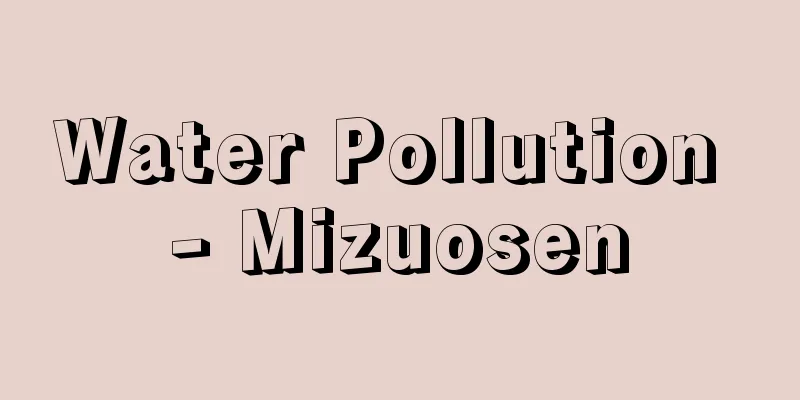Water Pollution - Mizuosen

|
When the inflow of sewage or industrial wastewater into a body of water changes the inherent properties of that water, to the point where it has a detrimental effect on drinking water, agriculture, fishing, and other aspects of daily life. This is one of the most typical forms of pollution in modern times. In Japan, many rivers flowing through large cities, such as the Sumida River and the Yodo River, became rapidly polluted from around the mid-1950s, and pollution also occurred in inland bays such as Tokyo Bay, Osaka Bay, Ise Bay, and Dokai Bay, as well as the Seto Inland Sea. The cause is generally domestic wastewater from households and industrial wastewater from various factories, but today domestic wastewater is considered to be the main cause rather than industrial wastewater. When nitrogen and phosphorus contained in domestic wastewater flow into closed waters such as lakes and bays, phytoplankton and aquatic plants multiply and die, causing eutrophication of the water, and causing red tides and blue-green algae to occur. In the 1980s, it also became clear that pollution of lakes, rivers, seas, and groundwater by harmful substances such as organochlorine compounds was widespread. Pollution caused by ordinary domestic wastewater results in significant proliferation of general bacteria and E. coli, anaerobic putrefaction due to a lack of dissolved oxygen, and an increase in ammoniacal nitrogen. Scientific standards for measuring the degree of pollution include pH value, amount of suspended solids, bacterial count, dissolved oxygen (DO), chemical oxygen demand (COD), biochemical oxygen demand (BOD), and total nitrogen. Generally, when it comes to rivers, a water body is considered clean if its BOD is below 5 parts per million (5 ppm). → Water quality conservation → Related topics Chromium pollution | Pollution-Related Health Damage Compensation Act | Basic Act for Pollution Control | Water Pollution Prevention Act | Trihalomethanes Source : Heibonsha Encyclopedia About MyPedia Information |
|
自然界のある水域の水が下水や産業排水の流入によって固有の性質を変え,飲用や農漁業など生活に有害な影響を及ぼすほどになること。現代の代表的な公害の一つ。日本では1950年代半ばごろから隅田川,淀川など大都市を流れる多くの河川が急激に汚濁の度を加え,また東京湾,大阪湾,伊勢湾,洞海湾などの内湾や瀬戸内海にも汚濁が発生。原因は一般的に家庭からの生活排水と各種工場などからの産業排水によるが,今日では産業排水よりも生活排水が主要な原因とされている。生活排水中に含まれている窒素やリンが湖沼,海湾など閉鎖性水域に流れ込むと,植物プランクトンや水草が増殖・枯死して水質の富栄養化が進行,赤潮や青粉が大発生する。また1980年代には有機塩素系化合物などの有害物質による湖沼,河川,海域,地下水の汚染が広がっていることも明らかになった。普通の生活排水による汚濁では一般細菌や大腸菌の増殖,溶存酸素不足による嫌気(けんき)性腐敗,アンモニア性窒素などの増加が著しい。汚濁の度合を測る科学的基準には,pH値,浮遊物質の量,細菌数,溶存酸素(DO),化学的酸素要求量(COD),生物化学的酸素要求量(BOD),総窒素量などがある。一般に河川の場合についていえば,BODが100万分の5(5ppm)以下なら清浄とみなされる。→水質保全 →関連項目クロム公害|公害健康被害補償法|公害対策基本法|水質汚濁防止法|トリハロメタン 出典 株式会社平凡社百科事典マイペディアについて 情報 |
<<: Water St. John's Wort - Water St. John's Wort
Recommend
Ternifine man
…Its morphological characteristics are similar to...
Hiyoshi [village] - Hiyoshi
A village in Kitauwa District, southwest of Ehime ...
Sindh - Sindh (English spelling)
A province in southeastern Pakistan. It has an are...
Big song - Oota
A general term for songs used at official Imperia...
Memorial tablet ceremony
...In this respect, Japanese families show variou...
International Labor Union - Kokusai Rouren
Abbreviation for World Confederation of Labour (WC...
Imuta Pond
Imuta is a crater lake of the Imuta volcano in Im...
Urey
A Japanese musical term. It is written with the ch...
Geometrid moth - Geometrid moth
A general term for insects in the Geometridae fami...
Acute coronary failure
…The typical pathology is angina pectoris, but an...
Szasz, T. (English spelling)
...An ideological trend in psychiatry that emerge...
Voltammetry
A general term for the study of electrolysis phen...
Cascahal [island] - Kasukaharu
...Population: 266,988 (1995). Founded in 1540 on...
Brachionus calyciflorus (Brachionus calyciflorus)
A rotifer of the family Brachionidae in the class ...
Agrobacterium tumefaciens (English name) Agrobacterium tumefaciens
…A type of plant club disease caused by Agrobacte...







![Michigan [State] - Michigan](/upload/images/67ccf03d6c9b0.webp)

